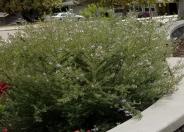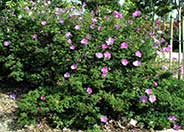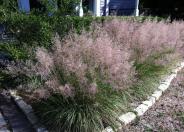
Common name:Germander Sage
Botanical name:Salvia chamaedryoides
This low mounding perennial with a long bloom period, spreads by underground runners. It produces a small, silvery foliage which serves as a background for bright blue flowers. Bruised leaves have a spicy fragrance. Germander Sage reaches 2' tall and wide. Heaviest blooms are in spring and early fall, but intermittent throughout the year. It requires full sun, well draining soil and is drought tolerant once it's established. Do not fertilize.

Common name:Blue Gem Westringia
Botanical name:Westringia 'Blue Gem'
This evergreen shrub will grow 3'-6' high and 6'-8' wide and has lavender flowers that bloom from winter through spring. It is drought tolerant and does well in full sun or partial shade. A more compact and showier selection that produces masses of luminous bluish purple flowers in spring and often lightly year-round. Perfect in tough spots; performs in sun, harsh inland heat or rugged coastal exposures, with minimal watering or care. Great in natural form, or shear into a low formal hedge. Evergreen.

Common name:Amazing Red Flax
Botanical name:Phormium 'Amazing Red'
Phormium 'Amazing Red' is an evergreen perennial. Big, dramatic plant composed of many swordlike, stiffly vertical leaves in a fan pattern. Flowers stems reach high above leaves, bearing clusters of 1-2 in. blossoms in red.

Common name:Blue Hibiscus
Botanical name:Alyogyne huegelii
This round shrub will grow about 6' tall x 6' wide and has medium-sized green leaves with lavender blue flowers that bloom all year.

Common name:Bull Rush
Botanical name:Muhlenbergia emersleyi 'El Toro'
El Toro grows in dense colonies in oak woodlands from Arizona to Texas. This clone was collected in southeastern Arizona, and was selected for its showy rosy-purple panicles. This petite, dense grass grows to about 2 feet tall and wide, with a slightly coarse texture. The long blue-green leaves are wider than many other Muhlenbergia species. In the fall months it sends up masses of loose, rosy-purple flower spikes, which dry to a tan color in the winter. This is one of the most drought-tolerant muhlys, and thrives in full sun and reflected heat locations. It also handles shady exposures, almost any soils, and is hardy to at least –100 degrees F. A vigorous spring pruning will remove any dormant foliage and flower spikes. Be careful not to cut back during the hot summer months! USDA Zone 6.
Designer:
Photographer: Vicki Anderson
Physical weed control, including mulching, or hand removal protects the watershed from harmful chemicals.
Develop healthy soil for plants that are vigorous and naturally pest-resistant.